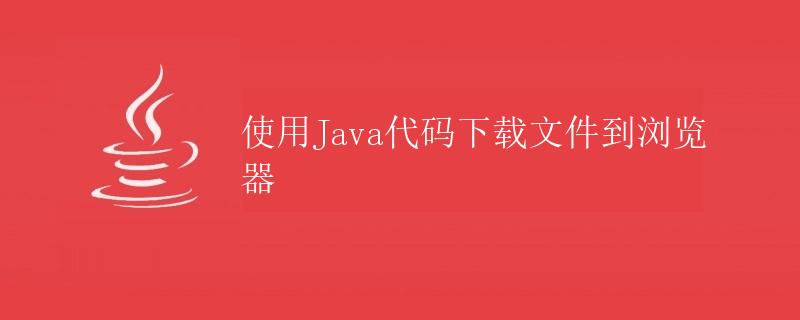使用Java代码下载文件到浏览器

引言
在Web开发中,有时候需要提供文件下载功能,即将服务器上的文件发送给客户端下载保存。Java语言作为一门广泛应用于Web开发的语言,也提供了丰富的API来实现文件下载功能。本文将介绍如何使用Java代码将文件下载到浏览器。
文件下载的原理
文件下载的原理是将服务器上的文件以流的形式发送给客户端浏览器,浏览器收到文件数据后将其保存到本地。在Java中,可以借助HttpServletResponse来实现这一过程。
Java代码实现文件下载功能
下面我们将使用Java代码来实现文件下载功能。
步骤1:创建Servlet
首先,我们需要创建一个Servlet来处理文件下载请求。在Servlet中,我们需要获取要下载的文件,并将文件内容写入HttpServletResponse的输出流中。
import javax.servlet.ServletException;
import javax.servlet.annotation.WebServlet;
import javax.servlet.http.HttpServlet;
import javax.servlet.http.HttpServletRequest;
import javax.servlet.http.HttpServletResponse;
import java.io.File;
import java.io.FileInputStream;
import java.io.IOException;
import java.io.OutputStream;
@WebServlet("/download")
public class FileDownloadServlet extends HttpServlet {
protected void doGet(HttpServletRequest request, HttpServletResponse response) throws ServletException, IOException {
String filePath = "路径/文件名"; // 要下载的文件路径
File file = new File(filePath);
FileInputStream fis = new FileInputStream(file);
// 设置响应头
response.setContentType("application/octet-stream");
response.setHeader("Content-Disposition", "attachment; filename=" + file.getName());
// 将文件内容写入输出流
OutputStream out = response.getOutputStream();
byte[] buffer = new byte[4096];
int bytesRead;
while ((bytesRead = fis.read(buffer)) != -1) {
out.write(buffer, 0, bytesRead);
}
fis.close();
out.flush();
out.close();
}
}
上述代码中,doGet方法用于处理GET请求,其中使用HttpServletResponse的输出流OutputStream将文件内容写入到浏览器中。设置响应头Content-Disposition为attachment可以保证浏览器以附件形式下载文件。
步骤2:配置Servlet
接下来,我们需要在web.xml或者使用Servlet 3.0的注解@WebServlet来配置我们的Servlet。
<!-- 在web.xml中配置Servlet -->
<servlet>
<servlet-name>FileDownloadServlet</servlet-name>
<servlet-class>com.example.FileDownloadServlet</servlet-class>
</servlet>
<servlet-mapping>
<servlet-name>FileDownloadServlet</servlet-name>
<url-pattern>/download</url-pattern>
</servlet-mapping>
或者使用Servlet 3.0的注解:
@WebServlet("/download")
public class FileDownloadServlet extends HttpServlet {
// ...
}
步骤3:调用文件下载接口
完成以上两个步骤后,我们可以通过访问 /download 接口来下载文件。在使用Java代码调用接口时,可以使用HttpURLConnection或者HttpClient等库来发送HTTP请求。
import java.io.*;
import java.net.HttpURLConnection;
import java.net.URL;
public class FileDownloader {
public static void main(String[] args) throws IOException {
URL url = new URL("http://localhost:8080/download");
HttpURLConnection conn = (HttpURLConnection) url.openConnection();
conn.setRequestMethod("GET");
int responseCode = conn.getResponseCode();
if (responseCode == HttpURLConnection.HTTP_OK) {
String fileName = conn.getHeaderField("Content-Disposition").split("=")[1];
InputStream inputStream = conn.getInputStream();
OutputStream outputStream = new FileOutputStream(fileName);
byte[] buffer = new byte[4096];
int bytesRead;
while ((bytesRead = inputStream.read(buffer)) != -1) {
outputStream.write(buffer, 0, bytesRead);
}
outputStream.close();
inputStream.close();
System.out.println("文件下载成功");
} else {
System.out.println("文件下载失败");
}
}
}
在调用/download接口后,代码会将文件保存到本地,并输出相应的下载结果。
结论
通过上述步骤,我们可以实现在Java代码中将文件下载到浏览器的功能。通过创建Servlet来处理下载请求,设置响应头为attachment,并将文件内容写入输出流,可以确保文件以下载方式呈现给用户。同时,在调用文件下载接口时,可以通过发送HTTP请求来实现文件的下载保存。
 极客笔记
极客笔记